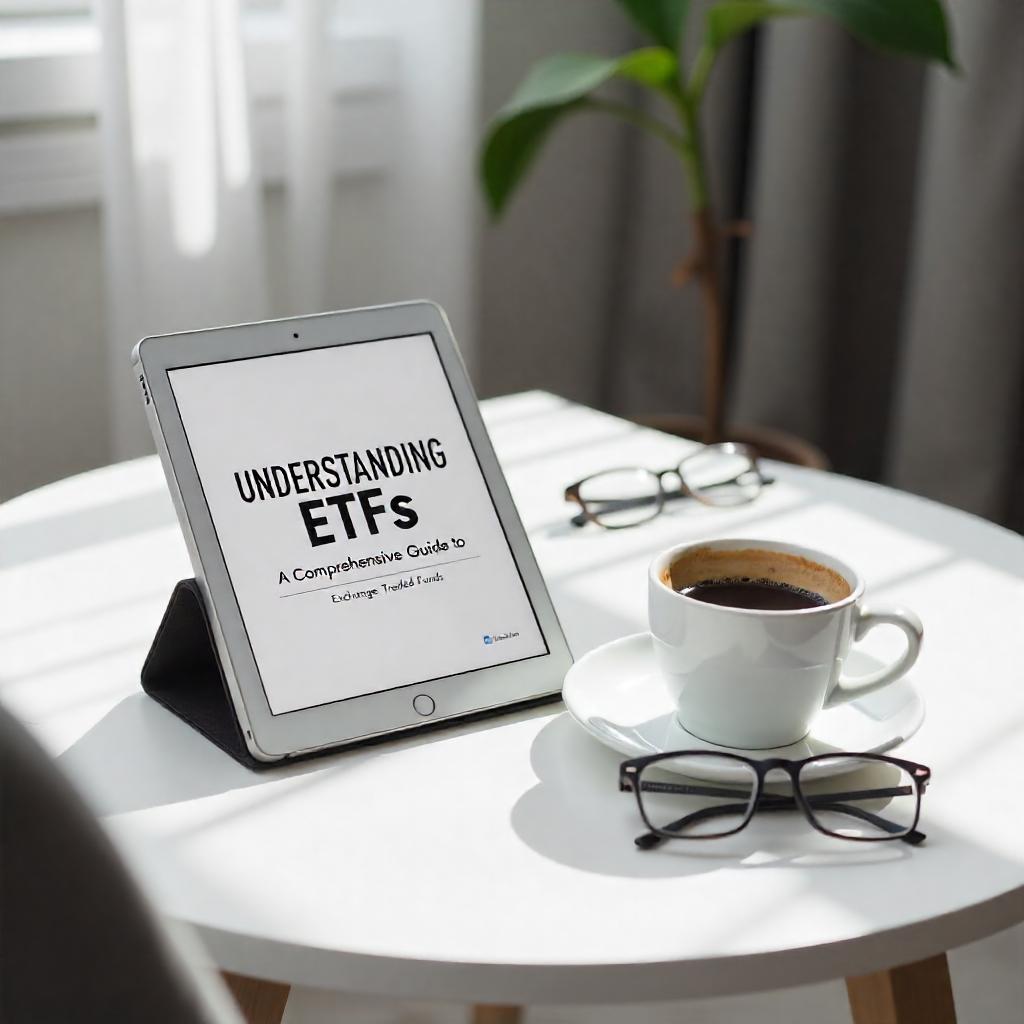Exchange-Traded Funds (ETFs) have gained significant popularity among investors in recent years due to their flexibility, cost-effectiveness, and ease of trading. This comprehensive guide will delve into the world of ETFs, exploring what they are, how they work, their advantages and disadvantages, types of ETFs, and much more. By the end of this article, you will have a thorough understanding of ETFs and how they can fit into your investment strategy.

What are ETFs?
Exchange-Traded Funds (ETFs) are investment funds that are traded on stock exchanges, much like individual stocks. They are designed to track the performance of a specific index, sector, commodity, or asset class. ETFs offer investors a way to gain exposure to a diversified portfolio of assets without having to buy each individual security.
Key Characteristics of ETFs
- Diversification: ETFs typically hold a collection of different securities, which can include stocks, bonds, commodities, or other assets. This diversification helps reduce risk compared to investing in individual securities.
- Liquidity: ETFs can be bought and sold throughout the trading day at market prices, just like stocks. This provides investors with the flexibility to enter and exit positions as needed.
- Cost-Effectiveness: ETFs generally have lower expense ratios compared to mutual funds. Additionally, because they are passively managed, their management fees are typically lower.
- Transparency: Most ETFs disclose their holdings on a daily basis, allowing investors to see exactly what they own at any given time.
- Tax Efficiency: ETFs are structured in a way that can minimize capital gains distributions, making them more tax-efficient than mutual funds.
How Do ETFs Work?
ETFs work by pooling money from multiple investors to create a fund that invests in a specific set of assets. Here’s a step-by-step breakdown of how ETFs operate:
- Creation and Redemption: Authorized participants (APs), which are typically large financial institutions, can create or redeem ETF shares. When creating shares, APs buy the underlying securities in the same proportion as the ETF’s index and deliver them to the ETF provider. In return, they receive ETF shares. Conversely, when redeeming shares, APs return ETF shares to the provider in exchange for the underlying securities.
- Trading on Exchanges: Once ETF shares are created, they are listed on stock exchanges where investors can buy and sell them just like any other stock. The price of an ETF share fluctuates throughout the trading day based on supply and demand.
- Tracking an Index: Most ETFs aim to replicate the performance of a specific index, such as the S&P 500 or the NASDAQ-100. They do this by holding a portfolio of securities that closely matches the composition of the index.
- Distributions: ETFs may pay dividends to investors if the underlying securities generate income. These dividends are typically distributed quarterly and can be reinvested or taken as cash.

Advantages of Investing in ETFs
1. Diversification
One of the primary benefits of ETFs is diversification. By investing in an ETF, you gain exposure to a broad range of assets, which can help mitigate risk. For example, an ETF that tracks the S&P 500 includes shares from 500 different companies, providing investors with a diversified portfolio in a single investment.
2. Cost-Effectiveness
ETFs generally have lower expense ratios compared to mutual funds. This is because most ETFs are passively managed, meaning they simply aim to replicate the performance of an index rather than actively selecting securities. Lower fees can significantly impact long-term returns.
3. Liquidity and Flexibility
ETFs trade on stock exchanges, allowing investors to buy and sell shares throughout the trading day. This liquidity provides investors with the flexibility to react quickly to market changes or to implement trading strategies.
4. Transparency
ETFs typically disclose their holdings on a daily basis, giving investors insight into the underlying assets. This transparency allows investors to make informed decisions and understand the risks associated with their investments.
5. Tax Efficiency
ETFs are structured to minimize capital gains distributions. This is largely due to the in-kind creation and redemption process, which allows investors to avoid triggering capital gains taxes when they buy or sell ETF shares.
Disadvantages of Investing in ETFs
1. Trading Costs
While ETFs generally have lower expense ratios, investors may incur trading commissions when buying and selling shares. Frequent trading can lead to higher costs, which can eat into returns.
2. Market Risks
Like all investments, ETFs are subject to market risks. The value of an ETF can fluctuate based on the performance of the underlying assets. If the market experiences a downturn, the value of the ETF may decline as well.
3. Tracking Error
ETFs aim to replicate the performance of an index, but they may not always do so perfectly. The difference between the ETF’s performance and the performance of the index it tracks is known as tracking error. Factors such as fees, expenses, and the fund’s structure can contribute to tracking error.
4. Limited Control Over Holdings
Investors in ETFs have limited control over the individual securities held within the fund. While this can be an advantage for those seeking diversification, it may not be suitable for investors who prefer to have more control over their investments.

Types of ETFs
There are several different types of ETFs, each serving different investment objectives. Here are some of the most common types:
1. Equity ETFs
Equity ETFs invest in stocks and are designed to track the performance of a specific index or sector. For example, the SPDR S&P 500 ETF (SPY) tracks the S&P 500 index, while the Invesco QQQ ETF (QQQ) tracks the NASDAQ-100 index.
2. Bond ETFs
Bond ETFs invest in fixed-income securities, such as government bonds, corporate bonds, or municipal bonds. These ETFs provide investors with exposure to the bond market while offering liquidity and diversification. An example of a bond ETF is the iShares iBoxx $ Investment Grade Corporate Bond ETF (LQD).
3. Commodity ETFs
Commodity ETFs invest in physical commodities such as gold, silver, oil, or agricultural products. These ETFs can provide investors with exposure to commodity prices without the need to physically hold the underlying assets. The SPDR Gold Shares (GLD) is a popular gold ETF.
4. Sector and Industry ETFs
Sector and industry ETFs focus on specific sectors of the economy, such as technology, healthcare, or energy. These ETFs allow investors to target particular industries for investment. For instance, the Select Sector SPDR Fund – Technology (XLF) focuses on technology stocks.
5. International ETFs
International ETFs invest in securities outside of the investor’s home country. These ETFs provide exposure to global markets and can help diversify an investment portfolio. The iShares MSCI Emerging Markets ETF (EEM) is an example of an international ETF.
6. Thematic ETFs
Thematic ETFs focus on specific investment themes or trends, such as clean energy, artificial intelligence, or cybersecurity. These ETFs allow investors to capitalize on emerging trends and innovations. For example, the Global X Robotics & Artificial Intelligence ETF (BOTZ) focuses on companies involved in robotics and AI.
7. Inverse and Leveraged ETFs
Inverse and leveraged ETFs are designed for short-term trading and aim to amplify returns based on the performance of an underlying index. Inverse ETFs seek to provide the opposite return of an index, while leveraged ETFs aim to deliver multiples of the index’s return. These ETFs carry higher risks and are generally not suitable for long-term investors.

How to Invest in ETFs
Investing in ETFs is relatively straightforward. Here are the steps to get started:
1. Open a Brokerage Account
To invest in ETFs, you’ll need to open a brokerage account. Choose a reputable brokerage that offers access to a wide range of ETFs and has low trading fees. Many online brokers provide user-friendly platforms for buying and selling ETFs.
2. Research ETFs
Before investing, research different ETFs to determine which ones align with your investment goals and risk tolerance. Consider factors such as the ETF’s expense ratio, performance history, and the underlying assets it holds.
3. Place an Order
Once you’ve chosen an ETF, you can place an order through your brokerage account. You can choose to place a market order (buying at the current market price) or a limit order (specifying a price at which you’re willing to buy).
4. Monitor Your Investment
After purchasing an ETF, regularly monitor its performance and review your investment strategy. Keep an eye on market trends and any changes in the underlying assets that may affect the ETF’s performance.
5. Rebalance Your Portfolio
As your investments grow and market conditions change, you may need to rebalance your portfolio to ensure it aligns with your investment goals. This may involve buying or selling ETFs to maintain your desired asset allocation.
Tax Implications of Investing in ETFs
Understanding the tax implications of investing in ETFs is essential for maximizing your returns. Here are some key points to consider:
1. Capital Gains Distributions
ETFs are generally more tax-efficient than mutual funds due to their structure. However, investors may still face capital gains distributions if the ETF manager sells securities within the fund. These distributions are typically taxed as short-term or long-term capital gains, depending on how long the securities were held.
2. Dividend Taxes
If an ETF pays dividends, investors will be taxed on those dividends. Qualified dividends are typically taxed at a lower rate than ordinary income, so it’s essential to understand the tax implications of any dividends received from your ETF investments.
3. Tax-Loss Harvesting
Investors can use tax-loss harvesting strategies to offset capital gains by selling underperforming ETFs at a loss. This strategy can help minimize tax liability and improve overall portfolio performance.
4. Retirement Accounts
Investing in ETFs within tax-advantaged accounts, such as IRAs or 401(k)s, can provide tax benefits. In these accounts, taxes on capital gains and dividends are deferred until withdrawal, allowing for potential tax-free growth.
Common Misconceptions About ETFs
Despite their growing popularity, several misconceptions about ETFs persist. Here are some common myths and the truths behind them:
1. ETFs are Only for Day Traders
While ETFs are popular among day traders due to their liquidity, they are also suitable for long-term investors. Many investors use ETFs as a core component of their investment strategy, holding them for extended periods to achieve diversification and exposure to specific markets.
2. All ETFs are Passively Managed
While many ETFs are passively managed, aiming to replicate the performance of an index, there are also actively managed ETFs that seek to outperform the market. These actively managed ETFs may have higher expense ratios and require more research.
3. ETFs are Risk-Free Investments
Like all investments, ETFs carry risks. The value of an ETF can fluctuate based on the performance of the underlying assets, and investors can lose money. It’s essential to understand the risks associated with any ETF before investing.
4. ETFs are Complicated to Understand
While the mechanics of ETFs may seem complex, they are relatively straightforward once you understand the basics. With proper research and education, investors can easily navigate the world of ETFs.
FAQs About ETFs
What is an ETF?
An ETF (Exchange-Traded Fund) is an investment fund that is traded on stock exchanges, similar to individual stocks. It typically holds a collection of securities and aims to track the performance of a specific index or asset class.
How do ETFs differ from mutual funds?
ETFs trade on stock exchanges and can be bought and sold throughout the trading day, while mutual funds are priced at the end of the trading day and can only be purchased or sold at that price. Additionally, ETFs generally have lower expense ratios than mutual funds.
Are ETFs suitable for long-term investing?
Yes, ETFs can be suitable for long-term investing. Many investors use ETFs to build diversified portfolios and gain exposure to specific markets or sectors over time.
How do I choose the right ETF for my investment strategy?
When choosing an ETF, consider factors such as the ETF’s expense ratio, performance history, underlying assets, and how it aligns with your investment goals and risk tolerance.
What are the tax implications of investing in ETFs?
ETFs are generally more tax-efficient than mutual funds due to their structure. However, investors may still face capital gains distributions and taxes on dividends received. Investing in ETFs within tax-advantaged accounts can provide additional tax benefits.
Can I invest in ETFs through a retirement account?
Yes, you can invest in ETFs through tax-advantaged retirement accounts such as IRAs or 401(k)s. This allows for potential tax-free growth and tax deferral on capital gains and dividends.
Are there risks associated with investing in ETFs?
Yes, ETFs carry risks, including market risk, tracking error, and potential trading costs. Investors should carefully consider these risks before investing in ETFs.
Conclusion
Exchange-Traded Funds (ETFs) offer a flexible and cost-effective way for investors to gain exposure to a diversified portfolio of assets. With their liquidity, transparency, and tax efficiency, ETFs have become a popular choice for both novice and experienced investors. By understanding how ETFs work, their advantages and disadvantages, and the various types available, you can make informed investment decisions that align with your financial goals.
As you explore the world of ETFs, remember to conduct thorough research and consider your risk tolerance and investment objectives. With the right approach, ETFs can be a valuable addition to your investment strategy, helping you achieve your financial goals while managing risk effectively. Whether you are looking for long-term growth, income generation, or sector exposure, there is likely an ETF that can meet your needs.


Pingback: Day Trading: A Comprehensive Guide For Aspiring Traders - Info Spher Hub
ETFs are indeed a fascinating investment tool, offering diversification and lower costs compared to mutual funds. The ability to trade them throughout the day adds a layer of flexibility that many investors appreciate. However, the mention of potential trading commissions and market risks is a good reminder that no investment is without its downsides. I’m curious, though, how do you decide which ETF to invest in when there are so many options available? The transparency of daily holdings is a big plus, but does it ever feel overwhelming to analyze all that data? Also, while the in-kind creation and redemption process minimizes capital gains, are there any other tax implications to be aware of? Overall, ETFs seem like a solid choice for long-term investing, but I wonder if they’re equally suitable for more active traders. What’s your take on balancing the benefits and risks when using ETFs in a portfolio?